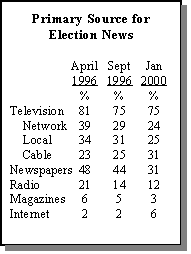Introduction and Summary
American voters are hard to reach and hard to move. They rely on a kaleidoscope of media outlets, old and new, to follow news about the presidential campaign — virtually all of which are given a mixed review for political objectivity. And most voters say that political endorsements by celebrities, local newspapers, religious leaders and union officials exert little influence on their voting decisions.

Network evening news broadcasts and newspapers, the principal conduits of campaign news for generations of Americans, are no longer predominant as their audiences dwindle and competition intensifies from cable in its many forms and, more recently, the Internet. Cable news and newspapers are named most frequently as the public’s primary source for presidential campaign news. But reflecting the highly fragmented media landscape, each is named as a primary news source by less than one-third (31%) of Americans. And the percentage naming newspapers has fallen significantly (from 48%) since April 1996, while the number naming cable has shown a modest increase (from 23%).
Three-quarters of Americans (75%) still cite television, broadly defined, as their main source for campaign news, but they clearly divide their preferences among cable, network and local outlets. And the playing field is no longer dominated by hard news sources, as significant numbers say they are learning about the candidates from network news magazines and, to some degree, entertainment programs. Half the respondents in the Pew Research Center’s most recent nationwide survey (conducted Jan. 12-16 among 1,091 adults) say they regularly (16%) or sometimes (35%) glean information about the candidates from comedy programs such as Saturday Night Live and non-traditional outlets like MTV. These figures rise to 24% and 55%, respectively, for those under age 30.
Given the vast number of available sources, there are considerable differences in the media on which various segments of the electorate rely:
While not as many voters turn to newspapers as in the past, they are the most useful source of campaign news for people who are involved in politics at the grass roots level. Those who are active in politics are also among the most likely to gain information on the campaign from a variety of media sources. In fact, this group is nearly twice as likely as less politically active Americans to learn something about the candidates from news magazines, public television, C-SPAN, cable political chat shows and Sunday morning talk shows.
Newspapers are also popular among older and affluent voters, as well as college graduates. But young people, those under age 30, are almost half as likely to identify the Internet (9%) as newspapers (21%) as their primary source for campaign news. Nearly half of young people (47%) say they have at least occasionally learned something about the campaign from late night entertainment programs, far more than any other age group.
Younger and better-educated people tend to learn more about the campaign from the Internet, compared to those who are older and less well-educated. But the Internet audience for campaign news, while growing rapidly, is still relatively small; overall, twice as many people consider radio (12%) their primary source of campaign news than the Internet (6%). Among those who go online, the number citing the Internet as their main source doubles to 12%.
Broadcast news, network and local, has declined significantly as a primary source for campaign news over the past four years. Among affluent Americans making $75,000 and over, local television now lags well behind newspapers, network television news and cable. But local television news is the leading source for campaign news among African-Americans (36%), those making less than $20,000 a year (38%) and those without a high-school diploma (39%).
There are few notable differences between Republicans and Democrats over the source of their campaign news. But 10% of Republicans say they regularly learn something about the presidential campaign from religious radio shows, against just 5% of Democrats. Republicans are also more likely than Democrats to gain information from talk radio programs.
While Americans have a broad array of sources of political news from which to choose, a strong majority (69%) sees at least a fair amount of political bias in news coverage. That is down from 76% in 1989, but the percentage of Americans who see the media as very biased has shown a modest increase (from 25% to 32%) in the past 11 years. Most news outlets receive paltry ratings for objectivity; only C-SPAN is regarded as completely objective by more than one-third (35%) of Americans.
Political endorsements, which have been declining in importance for some time, mean little to most Americans. Colin Powell is considered the most influential of 17 political leaders, celebrities and other people and institutions tested; more than one-quarter (27%) say Powell’s endorsement of a candidate would make it more likely they would vote for that person. Still, more than six-in-ten Americans (62%) say Powell’s endorsement would make no difference. And endorsements by some politicians and celebrities — including Newt Gingrich, Jesse Ventura and even Rosie O’Donnell — are seen as a political negative. On balance, more people say they would be less likely to vote for a candidate if that person was endorsed by Gingrich, Ventura or O’Donnell.




